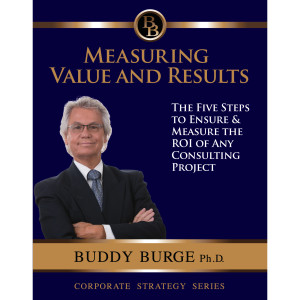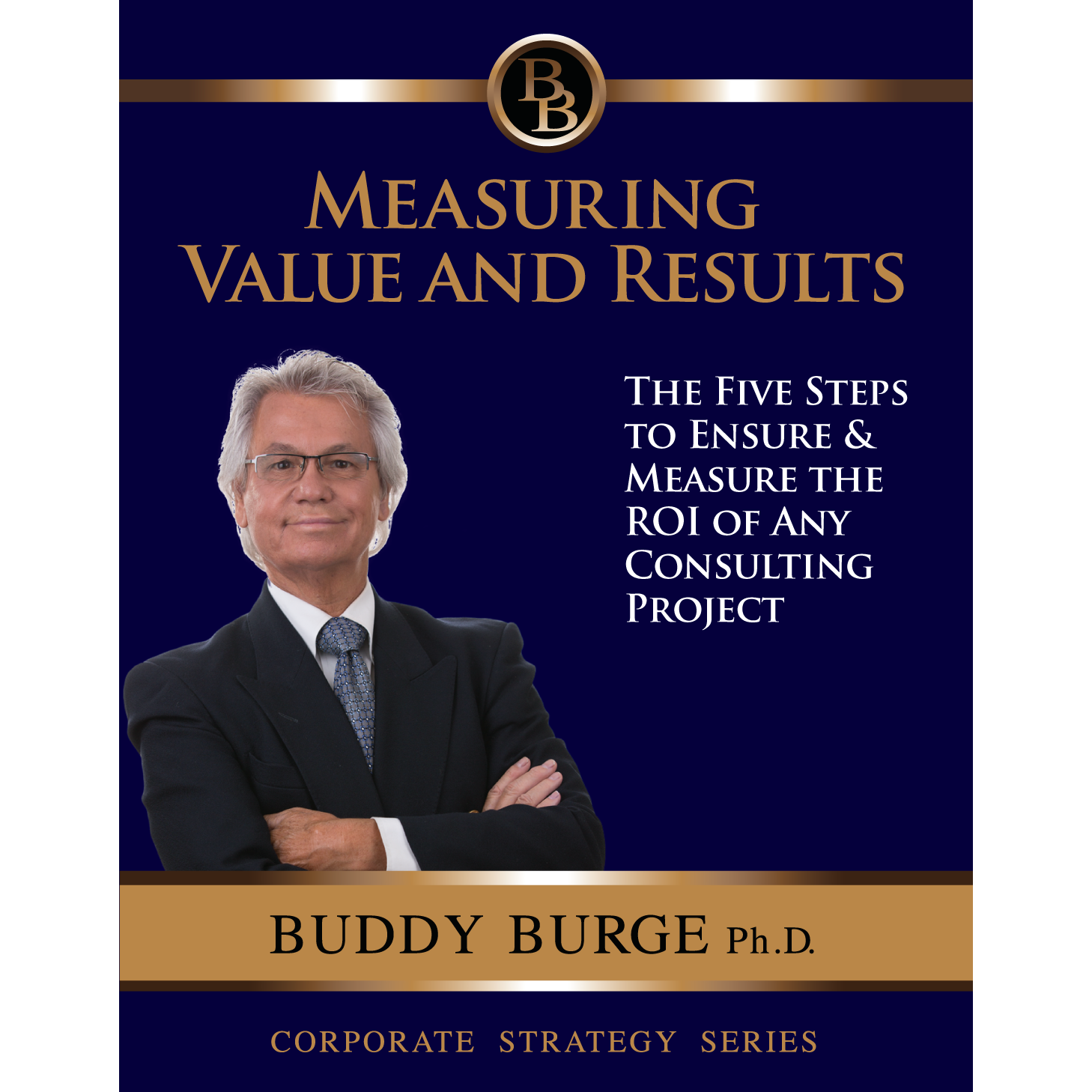This article is taken from “Measuring Value and Results”
Value Defined
What is meant by the term “Value”.
Value is one Thing
Succinctly said, value is not what we do (deliverable); it is what the client gets that helps them fix or improve their situation.
And it is getting what they want (the results we agree to) in the way they want in the time table we agree to.
It is also getting the client what they didn’t even know they wanted; helping the client think about what they think.
This sense of transcendence, thinking better because of how we listen needs to happen true shortly after the first few moments of the initial conversation.
I dwell quite extensively on this facilitative type of sales conversation in “Naked is the Salesperson who has no Close”, my book on the complex organizational sale.
At some point we know we have proffered value to the client when we hear them say something like, “You know Jimmy, I haven’t thought about this before but…”
This, the “What” the client wants, I call this Macro Value
In some way our partnership becomes very important to him, because his current situation was made better, as a result of what we have done with and for him at every stage in the relationship.
So value also implies that the client gets “What” they want it in the way they would most want it.
This last part is the “How” part of the equation; I call this Micro Value
in part two of this two-part article on value I will elaborate on the difference between the two, macro and micro value.
You could say that value means “We do not charge for what I do (time, deliverables and so forth); rather we charge for what they get.”
Value has Four Facets – Impact x Magnitude x Complexity x Expertise
Value has two dimensions and four facets.
The two dimensions are:
- The result (what the client gets)
- the process (how we go about getting that result)
These two dimensions are comprised of magnitude or impact (as to the result you get) in relation to the complexity and expertise (what I do) needed to get you that result.
The greater the magnitude of our work together, the greater the value, impact or your ROI will be.
This also means that the greater the magnitude of the project that in all likelihood, the more complex (intricate and sophisticated) my work with you will need to be.
The vertical axis Magnitude/Impact in the graph on the next page represents the level of impact (individual, group or the organization as a whole) that you (and your operation) want, need and expect from me predicated upon the option you choose.
The horizontal axis Complexity/Expertise is the level of involvement required for the level of impact you need and want from our work together.
With each subsequent level of impact (magnitude) greater expertise and more intricate involvement is required on my part to get you the results (value) that we have agreed to.
Value has two Dimensions and Three levels (Options)
Option One: Personal Mastery
(Individual X Coaching)
Option Two: Group Alignment
(Individual X Coaching X Group X Workshops)
Option Three: Organizational Transformation
(Individual X Coaching X Group X Workshops X Organization X Consultation)
![CropperCapture[594]](http://buddyburge.com/wp-content/uploads/2014/02/CropperCapture594.png)
Professional Speaking, Workshop, Advising and Coaching Fees
Let me use my practice as an example of what I mean by value.
In my practice, I much prefer a fee for the value our relationship brings to clients (we agree to what you want and need, and we get you that result) as opposed to fee for the service our relationship brings to clients (time, tasks, deliverables etc.)
In other words, you should pay me for what you get, not what I do.
When a consultant or adviser charges for his time, two subtle but insidious (yes, I did say insidious) things happen to their relationship, which are not good for either party but are especially bad for the client.
Reason Number One Why You Should Pay for Value, not Time
The consultant tends to want to increase the boundaries and deliverables initially cited in the contract, often doing less essential or less valuable activities (more interviews, studies, reports, focus groups etc), to extend the amount of time needed for the project (think lawyer, accountant).
And in so doing create more time (read revenue) for himself.
I do not want to be in a system that creates such a reaction.
You might argue that an honorable person wouldn’t do that.
Indeed, but even honorable people when push comes to shove, will sometimes jaywalk, fudge their expenses etc. for what they believe, given their particular situation, are perfectly justifiable reasons.
Hmmmmm.
Reason Number Two Why You Should Pay for Value, not Time
The second problem to charging for the amount of time I spend and not the results you get is that the relationship is then predicated on cross purposes, rather than trust.
One party, the consultant wants and needs more units of time and more revenue per unit while the other party (you) wants and needs fewer units of time and less cost per unit.
This can and often does make the relationship, one that must, by definition, be grounded on and infused with trust, become over time, rather uncomfortable, awkward or even adversarial.
In other words, at the basic agreement level, finances, we are already on an unspoken but different page.
Guess what that does to the most important thing in the relationship, trust. It ain’t good.
The Three Criteria for a Good Business Partnership
Fees, once we reach agreement on:
1) Your business objective(s)
2) The measurement of those objective(s)
3) The value (results) that is important to you,
Should be based not on time but upon the value inherent in the project, that is getting you the results we have agreed to.
Let me say it again, the focus is not nor should it ever be what I do or how I do it but what you get.
Having a “meter” running negates any partnership in which the most salient and singular feature is the trust both parties have in and for each other.
I also don’t want to place any client in the position of having to make an investment decision every time my help may be required.
You will not Lose Control of Expenses
With this arrangement, you can control expenses tightly and know your investment from the outset.
It also encourages you to call upon me without worrying about additional costs, and I’m free to suggest additional areas of focus I think are necessary without needing to ask you to increase your investment/cost.
To get you what you want within the objectives and parameters we have agreed to, I will commit as much time as necessary to fulfill the objectives we have agreed to.
“Jimmy, I thought we could get your group to where we wanted in three sessions. I think we will likely need another three. And as you know it is included in the initial fee agreement so the additional work on my part won’t cost you another penny.”
In other words, together, we can easily agree upon additional time being spent on aspects of a project without any additional fees or charges, except for travel expenses, if there are any.
Distinction in Value: An Example
![CropperCapture[411]](http://buddyburge.com/wp-content/uploads/2014/02/CropperCapture411-248x300.png)
Let me say it again, value is not what I do; a course or a book or a consulting engagement.
It is what you, the client gets.
Value is on balance, the client determining that you helped solved their problem, made their situation (world) better.
Value is the reason why the client needs what he needs and the extent to which the consultant or service provider can meet or exceed that need or expectation.
For instance, if my client had a sales team, the value would be represented in things like:
- Higher sales volume
- Higher dollar value per sale
- Faster closing rates
- Less cost per sale
- And so forth.
What Does The Client Really Want?
You can’t decide those things but you can speak with the client to determine the results that they are after; in other words:
1. Clarification as to what they really want (Business Objective)
2. Its measurement (Measurement)
3. And why the engagement is important to them (Value)
Once you know why, you can then suggest many ways to increase sales or increase closing rates.
Three levels of Value and Three Options
If we stick with increasing sales as an example, lower value but still valuable or helpful nonetheless, might be:
1. To teach one sales person a sales process or technique that might increase their personal closing rate by 10%.
Let’s suppose that the client with this option makes or saves $10,000.00.
2. A second approach (option) might be to teach the entire sales department a sales process or technique that might increase their personal closing rate by 10%.
Let’s suppose that the client with this option makes or saves $100,000.00.
3. Another higher value way is to increase the overall sales productivity of the team by making the product easier to sell, resulting in a companywide increase of perhaps $2,000,000.00.
Let’s suppose that the client with this option makes or saves $1,000,000.00.
1. Suggestion One becomes Option One:
Value: $10,000.00
(Individual X Coaching)
2. Suggestion Two becomes Option Two:
Value: $100,000.00
(Individual X Coaching X Group X Workshops)
3. Suggestion Three becomes Option Three:
Value: $2,000,000.00
(Individual X Coaching X Group X Workshops X Organization X Consultation)
Please note that the value is in the ROI the client gets with each option $10,000.00, $100,000.00 or $1,000,000.00, there are also more subjective results such as more time, less refereeing as well.
You can also see that my role with each subsequent option becomes more involved and complex requiring greater levels of expertise.
An Important Caveat
Where this definition of value needs to be calibrated is that the magnitude/impact of coaching a CEO may create more ROI than working a lower level executive or even helping an entire lower level team, which of course would include more people.
Why?
The CEO can change the situation faster, better and safer than anyone else, because he just has to change himself and everything around him will change, significantly.
In other words, if I can help the CEO then indirectly I/we have the impact and magnitude that we seeking as it relates to value.
So magnitude has to do with the level of influence that we are affecting and the degree of impact or ROI on the company, not merely the extent of my or the consultant’s involvement in the organization.
In this workbook we study, the five levels of “Value” and how they can be measured and applied in your practice.
Now that we have established and defined what we mean by value, its dimensions, in part two we will discuss the two kinds of value we can provide to clients; macro and micro value.
For more on this topic, we recommend the following | |
 | Measuring Value and ResultsThe Five Steps to Ensure and Measure Click Here For Video and Full Description If you found this article useful |


![CropperCapture[405]](http://buddyburge.com/wp-content/uploads/2014/02/CropperCapture405-300x285.png)
![CropperCapture[406]](http://buddyburge.com/wp-content/uploads/2014/02/CropperCapture406-300x256.png)
![CropperCapture[408]](http://buddyburge.com/wp-content/uploads/2014/02/CropperCapture408-300x226.png)
![CropperCapture[409]](http://buddyburge.com/wp-content/uploads/2014/02/CropperCapture409-300x230.png)
![CropperCapture[410]](http://buddyburge.com/wp-content/uploads/2014/02/CropperCapture410-300x198.png)
![CropperCapture[412]](http://buddyburge.com/wp-content/uploads/2014/02/CropperCapture412-300x243.png)
